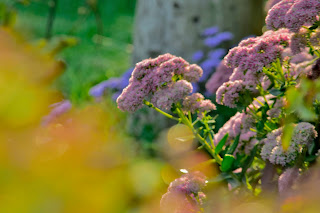 |
| early morning, September 30 |
This morning fog in concert with dawn light and deciduous woodland serve as reminder of how/when/why we see dimly, summoning lines from the chapter on Love: “For now we see in a mirror dimly” (1Cor 13:12). And, as the word selection points out, sight into the divine remains a puzzle: we see enigmatically. Ellicott’s Commentary for English Readers elaborates on the passage from Corinthians:
“Through a glass, darkly.--Better, through a mirror in a dark saying. The illustration here is from a mirror when the image appears far behind the mirror itself. If we remember the imperfect metal surfaces which formed the mirrors of those days, we can imagine how imperfect and enigmatical (the Greek word is "in an enigma") would the image appear; so that the Apostle says, "Like that image which you see when you look at an object in a mirror far off, with blurred and undefined outline, such is our knowledge here and now; but then (i.e., when this dispensation is at an end) we shall see as you see a man when you stand before him face to face.”
And yet even in the dim and puzzling view, how powerfully may we be touched, moved by Beauty.
 |
| view through window screen, Sept 29 |
“They [mystics] have never been deceived by phenomena, nor by the careful logic of the industrious intellect. One after another, with extraordinary unanimity, they have rejected that appeal to the unreal world of appearance which is the standard of sensible men: affirming that there is another way, another secret, by which the conscious self may reach the actuality which it seeks. More complete in their grasp of experience than the votaries of intellect or of sense, they accept as central for life those spiritual messages which are mediated by religion, by beauty, and by pain. . .
We must perceive in it, as some mystics have done, “the beating of the Heart of God”; and agree with Heracleitus that “there is but one wisdom, to understand the knowledge by which all things are steered through the All.” Union with reality—apprehension of it—will upon this hypothesis be union with life at its most intense point: in its most dynamic aspect. . .
The Indian mystics declare substantially the same truth when they say that the illusion of finitude is only to be escaped by relapsing into the substantial and universal life, abolishing individuality. So too, by a deliberate self-abandonment to that which Plato calls the “saving madness” of ecstasy, did the initiates of Dionysus “draw near to God.” So their Christian cousins assert that “self-surrender” is the only way: that they must die to live, must lose to find: that knowing implies being: that the method and secret which they have always practiced consists merely in a meek and loving union—the synthesis of passion and self-sacrifice—with that divine and unseparated life, that larger consciousness in which the soul is grounded, and which they hold to be an aspect of the life of God. In their hours of contemplation, they deliberately empty themselves of the false images of the intellect, neglect the cinematograph of sense. Then only are they capable of transcending the merely intellectual levels of consciousness, and perceiving that Reality which “hath no image.” (Mysticism: The Development of Humankind’s Spiritual Consciousness, pp. 23, 30, 31-32)
To move closer to the Divine, we must search out a view of beauty like that of a dew-dampened web, like the love that links us in relationships with all others, all of nature, all humankind, and beyond.
Underhill again:
“Pilgrimage to the place of the wise,” said Jalalu ‘ddin, “is to find escape from the flame of separation.” It is the mystics’ secret in a nutshell. “When I stand empty in God’s will and empty of God’s will and of all His works and of God Himself,” cries Eckhart with his usual violence of language, “then am I above all creatures and am neither God nor creature, but I am what I was and evermore shall be.” He attains, that is to say, by this escape from a narrow selfhood, not to identity with God—that were only conceivable upon a basis of pantheism—but to an identity with his own substantial life, and through it with the life of a real and living universe; in symbolic language, with “the thought of the Divine Mind” whereby union with that Mind in the essence or ground of the soul becomes possible. The first great message of Vitalistic philosophy is then seen to be—Cease to identify your intellect and your self: a primary lesson which none who purpose the study of mysticism may neglect. Become at least aware of, if you cannot “know,” the larger, truer self: that root and depth of spirit, as St. François de Sales calls it, from which intellect and feeling grow as fingers from the palm of the hand—that free creative self which constitutes your true life, as distinguished from the scrap of consciousness which is its servant (Mysticism, p. 32).

















